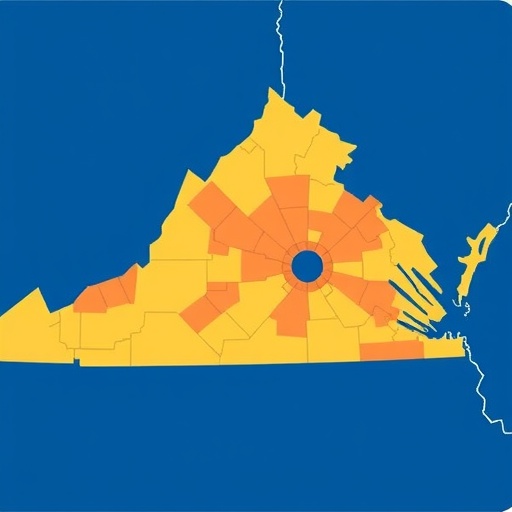Virginia Redistricting Efforts Surge Amid National Political Shifts and Legal Challenges
In a pivotal shift that’s captivating political observers nationwide, Virginia is poised to redraw its congressional and state legislative maps, aligning with a burgeoning trend of redistricting reforms across the U.S. This move comes as courts and commissions in multiple states scrutinize electoral boundaries for fairness, amid accusations of gerrymandering that have long skewed Virginia‘s politics. With the 2024 elections looming, the Old Dominion State’s efforts could reshape power dynamics in Congress and statehouses, potentially tipping the balance in a divided nation.
- Virginia’s Bipartisan Commission Steps Up to Redraw the Lines
- Legal Challenges Fuel Virginia’s Redistricting Momentum
- National Redistricting Wave Reshapes U.S. Politics with Virginia in the Spotlight
- Stakeholder Voices and Voter Impacts in Virginia’s Redistricting Drama
- Looking Ahead: Redistricting’s Ripple Effects on Virginia’s Political Future
The catalyst for Virginia’s redistricting push is a confluence of legal rulings and grassroots demands for equitable representation. Just last month, a federal appeals court upheld challenges to similar maps in neighboring states, setting a precedent that Virginia Democrats and voting rights advocates are eager to leverage. According to the Brennan Center for Justice, over 180 congressional districts nationwide face potential redraws due to ongoing litigation, with Virginia’s Ninth District—often criticized for its irregular shape—emerging as a prime target. This isn’t mere bureaucratic tinkering; it’s a high-stakes battle over who holds the reins in American democracy.
Virginia’s Bipartisan Commission Steps Up to Redraw the Lines
At the heart of Virginia’s redistricting initiative is the state’s independent redistricting commission, established in 2020 through a voter-approved constitutional amendment. This body, comprising equal numbers of Democrats, Republicans, and independents, is now convening public hearings across Richmond, Norfolk, and Roanoke to gather input on new maps. Commission Chair Chris Jones, a former Republican delegate, emphasized the urgency in a recent statement: “Virginia’s politics have been distorted by outdated districts that no longer reflect our diverse population. We’re committed to creating fair maps that empower every voter, regardless of party.”
The commission’s work builds on the 2021 redistricting cycle, which saw Virginia become one of the first states to use an independent panel for congressional lines. However, that process faced backlash when a state court struck down initial proposals for favoring urban areas. Fast-forward to today, and census data from 2020 reveals stark demographic shifts: Virginia’s population grew by 7.4%, with significant increases in Hispanic and Asian communities in Northern Virginia suburbs. These changes demand adjustments to ensure districts adhere to the Voting Rights Act, avoiding dilution of minority voices.
Statistics underscore the stakes. A report from the Princeton Gerrymandering Project rates Virginia’s current congressional map as having a “high” gerrymander score, meaning it disproportionately benefits one party—in this case, Republicans in rural areas—despite the state’s near-even partisan split. Under the commission’s proposed timeline, draft maps will be released by mid-2024, with final approval targeted for September. Public participation is key; over 5,000 comments were submitted in the last cycle, influencing tweaks to districts in Fairfax and Prince William Counties.
Legal Challenges Fuel Virginia’s Redistricting Momentum
Virginia’s redistricting drive is inextricably linked to a cascade of legal challenges rippling through the U.S. judiciary. In a landmark 2023 Supreme Court decision, the justices declined to intervene in North Carolina’s map overhaul, effectively greenlighting state-level reforms. This ruling has emboldened challengers in Virginia, where the American Civil Liberties Union (ACLU) filed a lawsuit last week alleging that the existing state Senate districts violate the Equal Protection Clause by packing Black voters into fewer seats.
Attorney General Jason Miyares, a Republican, has voiced cautious support for the commission’s role, telling reporters, “While politics in Virginia is fiercely competitive, our legal framework ensures that redistricting isn’t a partisan weapon. We’re watching these cases closely to protect electoral integrity.” Yet, tensions simmer: Democrats argue that Republican-led gerrymanders from the 2010s locked in GOP majorities, while Republicans counter that urban growth naturally favors Democrats, necessitating balanced adjustments.
Nationally, the trend is clear. States like New York and Ohio have seen courts impose new maps after finding evidence of intentional bias, with Virginia’s efforts mirroring these. A Princeton study estimates that fairer redistricting could shift up to 10 House seats nationwide by 2026, including Virginia’s competitive Fourth and Seventh Districts. In Virginia specifically, litigation costs have already topped $2 million since 2021, funded partly by taxpayer dollars and advocacy groups like the League of Women Voters.
To illustrate the process, consider the step-by-step legal pathway:
- Initial Challenges: Lawsuits filed in state or federal courts citing constitutional violations.
- Court Reviews: Judges appoint special masters to propose alternative maps using neutral criteria like compactness and population equality.
- Public Input: Hearings allow community feedback, as seen in Virginia’s ongoing sessions.
- Final Adjudication: Appeals can reach the Supreme Court, though most cases resolve at lower levels.
This structured approach aims to depoliticize redistricting, but skeptics warn of delays that could disrupt the 2024 cycle.
National Redistricting Wave Reshapes U.S. Politics with Virginia in the Spotlight
Virginia’s actions are part of a larger national redistricting renaissance, driven by post-2020 census updates and heightened scrutiny of electoral fairness. Across the U.S., 10 states have enacted independent commissions since 2018, up from just four a decade ago. Michigan’s citizen-led panel, for instance, produced maps in 2022 that flipped four congressional seats to Democrats, demonstrating the tangible impact on politics.
In Virginia, this wave intersects with broader political shifts. The state’s trifecta—Democratic control of the governorship and both legislative chambers since 2021—provides momentum for progressive reforms. Governor Glenn Youngkin, despite his Republican affiliation, has pledged not to veto commission-approved maps, signaling a rare bipartisan consensus. Political analysts like Larry Sabato from the University of Virginia note, “Virginia’s redistricting is a microcosm of national trends. As suburbs boom and rural areas stabilize, maps must evolve to capture these realities, or risk alienating voters.”
Comparative data highlights the urgency. The Cook Political Report classifies seven of Virginia’s 11 congressional districts as competitive, more than in gerrymander-heavy states like Texas. Yet, a 2023 Pew Research Center survey found that 62% of Virginians believe current districts favor one party, fueling calls for change. This sentiment echoes in other battlegrounds: Pennsylvania’s 2022 maps, redrawn after court intervention, led to a Democratic House gain, while Georgia’s ongoing fights could influence Senate races.
Economically, redistricting carries weight too. Fairer districts could boost investment in underrepresented areas; for example, redrawing Virginia’s rural districts might channel more federal funds to infrastructure in the Shenandoah Valley, where poverty rates hover at 12%. Advocacy groups like Common Cause Virginia are mobilizing, with petitions garnering 15,000 signatures urging the commission to prioritize racial equity.
Stakeholder Voices and Voter Impacts in Virginia’s Redistricting Drama
The human element of Virginia’s redistricting cannot be overstated, as diverse stakeholders weigh in on how new maps will affect everyday lives. Community leaders in majority-minority districts, such as those in Richmond’s East End, fear that poorly drawn lines could suppress turnout among Black voters, who comprise 19% of the state’s population. Reverend Robert Wright, a local activist, shared at a recent hearing: “Redistricting isn’t abstract—it’s about ensuring my community’s voice isn’t drowned out in the halls of power.”
On the Republican side, rural lawmakers like Delegate Chris Runion argue for preserving community integrity. “Politics in Virginia thrives on local representation,” Runion said. “We can’t let urban sprawl erase the unique needs of our farming districts.” This divide underscores the commission’s delicate balancing act, using tools like GIS mapping to create compact districts that respect county lines while achieving population parity—each congressional district must have roughly 810,000 residents.
Voter impacts are profound. Simulations from the Dave’s Redistricting app suggest that equitable maps could make three additional Virginia House races toss-ups, potentially flipping the chamber’s slim Democratic majority. For state politics, redrawn Senate lines might safeguard progressive priorities like education funding and abortion rights, especially after the 2023 legislative session’s expansions.
Broader context includes technology’s role: AI-driven algorithms now assist in map-drawing, reducing bias, though ethicists caution against over-reliance. In Virginia, the commission has adopted open-source software to ensure transparency, allowing public scrutiny of data inputs like voting patterns and socioeconomic metrics.
Looking Ahead: Redistricting’s Ripple Effects on Virginia’s Political Future
As Virginia’s redistricting process unfolds, its outcomes will reverberate through upcoming elections and beyond. By fall 2024, new maps could debut in time for primaries, influencing candidate recruitment and fundraising—Democrats are already targeting the redrawn Second District along the Hampton Roads coast. Nationally, Virginia’s model might inspire holdout states like Florida, where Governor Ron DeSantis faces his own map battles.
Experts predict that successful reforms could enhance trust in institutions; a 2023 Gallup poll shows only 28% of Americans confident in the electoral system, with redistricting cited as a key concern. For Virginia voters, the next steps involve monitoring commission votes and potential appeals, with resources like the Virginia Public Access Project offering real-time updates. Ultimately, this redistricting saga reinforces Virginia’s role as a bellwether in U.S. politics, where fair maps promise a more representative democracy for generations to come.
In the coming months, stakeholders anticipate intensified lobbying, with business groups like the Virginia Chamber of Commerce advocating for districts that promote economic growth. As one analyst put it, “Virginia’s redistricting isn’t just about lines on a map—it’s about redrawing the future of American governance.” With stakes this high, all eyes remain on Richmond.









